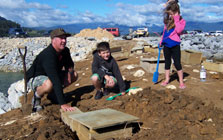Get started
Introduction
Find out how to get your project off to a great start by doing some initial thinking and research, identifying who to involve, finding out what people think and holding a project meeting.You are at the point where you want to kick off a conservation project. How do you get your project off to a great start? Typically, starting off involves the following steps:
- Doing some initial thinking and research
- Identifying who to involve
- Finding out what people think
- Holding a project meeting
You can use the getting started worksheet (PDF, 63K) to help your group get started. Work through the questions as a group, fill it in as you go and refer back to this section for ideas.
Initial thinking and research
As part of an initial ‘brainstorming’ it may be useful to work through the following questions to help clarify the purpose and objectives of your project:
- Why do we need the project?
- What is the problem we are trying to solve or the outcome we are seeking?
- Why do I care about this issue?
- What information already exists about this issue?
- Has this or a similar project been attempted before?
- What evidence of community interest is there?
- Who could I/we work with?
- What resources might be needed?
These questions could be discussed at an initial meeting about the project and also considered again when you’re setting your direction.
Identifying who to involve
Support from the right people can make or break a project. Talk to others and think about:
- Who’s likely to have an interest in the conservation issue and efforts to deal with it? Why is it important to them? Examples might include local councils, existing conservation or Landcare groups and iwi/hapu.
- Who might be affected by anything you do to deal with the issue e.g. landowners, neighbours, recreational users or iwi/hapu?
- What agencies might have a legal responsibility or interest in the issue or place? What role might they take?
- Who has influence or standing in the community e.g. local councillors, community board members or iwi/hapu representatives?
- Who is enthusiastic and likely to have time and energy for the project?
When the project involves parties to the Treaty of Waitangi (tangata whenua and Crown), it is also important to acknowledge:
- The unique status of tangata whenua and associated obligations;
- Kawangatanga (governance) and statutory responsibilities of agencies.
If you are not a member of a Maori community, and unfamiliar with the local situation, you’ll need to understand who the tangata whenua (local iwi/hapu) are, their kawa (protocols) and who has interests in the taonga (cultural treasures) your conservation project is concerned with.

Tarakohe Harbour penguin habitat project
Finding out what people think
It is also important to find out what people feel about your project idea and assess if there’s support for a group effort. Some key things to explore with people are:
- How and why they might be interested in the project.
- Whether people are already working on the project or a similar or related project.
- Any community issues or relationships that may need to be recognised or addressed.
- What they’d like to see achieved by the project.
- Any information needs or gaps.
The easiest way to find out what people think is to ask! Here are some ideas:
- Set up a display outside the local supermarket.
- Hold an open day or a site visit.
- Visit people in their own environment e.g. talk to the volunteer fire brigade, attend a meeting of the fishing club or the local marae committee.
- Put something in the local paper or over the local radio station.
Whether or not you’re legally required to consult and talk with others, the process allows people to have input into your plans and informs them about what’s happening.
See consulting with others for information on methods and techniques for consulting and working effectively with others, including tangata whenua.
Holding a project meeting
Once you’ve established initial support to talk about the project idea, you’re likely to need a meeting. Your first meeting might be to test ideas more widely, to endorse and confirm informal discussions or to launch your project. Depending on your purpose, the meeting might only include key people or be open to the wider community.
Face-to-face meetings can be valuable when:
- You’re requesting a commitment and support from people.
- You need a team decision.
- You want group synergy.
- You need different perspectives on an issue.
- People need to express their point of view and be heard.
Typically the purpose of the first meeting is to:
- Bring together people who are interested in the project.
- Allow for discussion of the project.
- Confirm whether the project is a ‘goer’ for a community effort.
- Identify the next steps. This may include commitment to form a group.
Effective, enjoyable meetings don’t just happen by accident. They require planning and attention to meeting process. There are a lot of little things to remember when you’re organising a meeting. See organising meetings and events for information and ideas to help organise meetings.
See facilitating effective meetings for information and strategies to help you facilitate a meeting and ensure it achieves the group’s purpose. It also provides tips for those making presentations at meetings.
The meeting or event planning checklist (PDF, 40K) may also help with your task.
